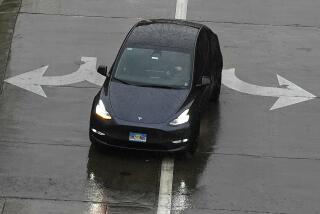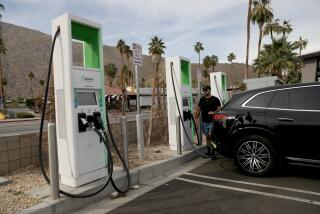Car review: VWâs all-electric e-Golf is as zippy and roomy as gas version
In light of the still-widening diesel emissions scandal, itâs no surprise that Volkswagen came to the Los Angeles Auto Show promoting an electric car.
The German car company brought a fleet of the sporty e-Golf battery electric vehicles to the show, eagerly throwing the keys to anyone willing to take a test drive.
The car is worth promoting. The VW e-Golf is a spirited runabout that deserves its place in the popular Golf family. In going electric, it makes almost no compromises in terms of performance, comfort or cargo space. It looks like a Golf, and it runs like a Golf.
And like most battery electric vehicles, it costs too much, takes too long to recharge, and has too little range.
Volkswagen, though seemingly late to the battery electric game, has been testing fully electric prototypes since the 1980s. Introducing the e-Golf as a model year 2015 car, itâs now entering a crowded field. I count more than a dozen contenders, among them league leaders Tesla Model S and Nissan Leaf.
Other than the Tesla â which can drive three times farther than any other BEV but also costs at least three times more â electric cars on the market include the Fiat 500e, BMW i3, Chevy Spark, Ford Focus, Kia Soul, Mitsubishi i-MiEV, Smart EV and Mercedes B-Class.
The e-Golf lands near the top in terms of range, a promised 83 miles between charges â not far behind 93 for the Kia, 87 for the Fiat, 85 for the Mercedes and 84 for the Leaf â and in the middle in terms of price, less than the BMW or Mercedes, about the same as the Fiat and the Kia, and well above the Ford or Chevy.
The base SE model starts at $29,815, and the SEL Premium at $36,415, before government incentives. But leasing is often a better option for electric cars because of their uncertain resale value and often attractive deals from automakers and dealers.
Volkswagen has been rocked by federal investigations, consumer outrage and class-action lawsuits since admitting that it installed illegal software âdefeat devicesâ designed to fool U.S. emissions tests. The software was installed in about 11 million cars worldwide and 482,000 in the U.S.
In the wake of the scandal, which will cost VW billions of dollars, the company said it would spend at least $100 million in 2016 to push further into electric and hydrogen fuel cell powertrains.
The e-Golf gives some insight into the companyâs ability to deliver on electric powertrains. VW executives have said they didnât want to come to market with an electric car that didnât perform well. They wanted, said product manager Mike Klopotowski, âan electric Golf that drives like a Golf, not like an electric car.â
That meant it had to go fast, handle well and accommodate five passengers and some luggage. It had to appeal to younger early adopters who wanted a zero-emission car, as well as aging baby boomers and empty-nesters, who didnât want something that screamed EV.
âIt couldnât look like a spaceship,â Klopotowski said. âThe older buyers donât want something too futuristic.â
After a week in the e-Golf, Iâd say Klopotowski and company have succeeded. The car is zippy and fun to drive. Like all electric cars, itâs extremely quiet and vibration free. Itâs just as comfortable as its fellow Golfs, with a pleasantly firm ride and all the key dashboard components visible and all the important functions in easy reach. It has excellent visibility.
Importantly, it drives much more like a sports car with 115 horsepower and 199 pound-feet of torque than something designed to save the planet. In âBâ regenerative braking mode, particularly, the accelerator response is instantaneous, making the car quick to dash forward and aggressive to brake.
Unlike some of its smaller competitors â ciao, Fiat! â the e-Golf has full-size back seats for full-size adults. The fit and finish, front and back, is up to German standards. It is reasonable to assume the electric Golf will stand the wear and tear of American roads as durably as its gasoline and diesel versions have done.
The e-Golf comes in two trim levels â the SE and the SEL Premium, the model I drove. The higher-cost version includes higher-grade navigation and infotainment â a $395 Driver Assistance Package includes some extra safety features â plus on-board hardware that will allow the SEL to take advantage of the DC fast-charging system, which cuts the recharge time from about 10 hours on a 120-volt plug, or four hours with 240 volts, to around 30 minutes on a fast charger.
But despite their popularity with the motoring press, strong performance and heavy subsidies, the pure electrics donât sell well.
Sales of all cars with batteries â including popular hybrids, such as the Prius â represented only 3.4% of U.S. car transaction sales in 2014, according to the Electric Drive Transportation Assn. (That percentage is down to about 3% so far this year.) And cars running only on batteries â with no gas engine â represented less than a fifth of those sales.
SIGN UP for the free California Inc. business newsletter >>
Most drivers report ârange anxietyâ and the recharging time as the reasons they wouldnât go fully electric â no matter the brand. (Hybrids donât need recharging, though plug-in hybrids allow charging and have some electric-only range.) Thatâs why hopes are high for Teslaâs promised Model 3 and Chevyâs Bolt, both of which promise much longer driving ranges.
The e-Golf promises 83 miles of âreal worldâ driving range, meaning the car doesnât have to be babied along to get the most out of a charge. After a week in the vehicle, Iâd say thatâs about right. I live in a hilly area and drove the car to maximize its sporty feel, and I was on target to run out of juice somewhere above 80 miles.
That doesnât mean I didnât experience range anxiety. The e-Golf has three range estimators â a gas gauge-style dial showing charge level, a range number next to the gas pump icon on the dash, and a second range number inside the infotainment screen.
These last two numbers were always different. I started with 83 miles in the tank. After a few daysâ commuting back and forth to work, I found I had 63 milesâ range left, on one gauge â but only 41 on the other.
Studies have shown that almost all Americans could commute quite comfortably with 83 miles of range. But not all of us have plug-in parking spaces at work, and apartment dwellers may not have easy access to plug-in spots at home. And thereâs still that lurking question in many driversâ minds: What if I wanted to just take off for Vegas?
But VW says most e-Golf buyers already own something different for their weekend excursions.
Klopotowski also said an increasing number of e-Golf buyers arrived at the dealerships looking at gasoline-powered Golfs, and left with the electric versions.
Is 83 a big enough number to persuade other drivers to convert? In the first year on offer, VW sales numbers shot past all but three other brands â behind only Tesla, Nissan and Fiat.
For those who do choose to plug in, the e-Golf should make an attractive daily driver. And VW, given its diesel scandal, could use more sales of cars without tailpipes.
ALSO
In detail: The cars of the 2015 L.A. Auto Show
Tesla recalls all Model S cars over seat belt issue
Porsche 911 Targa 4 GTS review: Fast, fun and surprisingly comfortable







